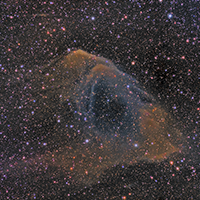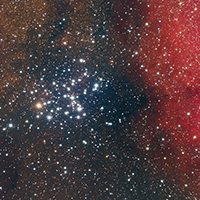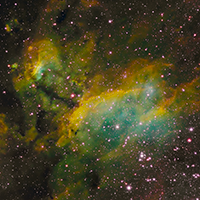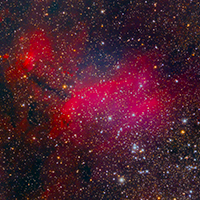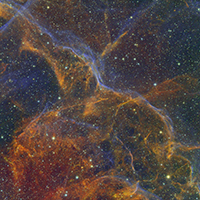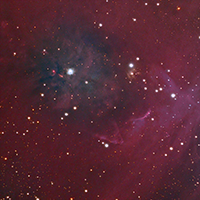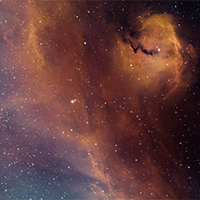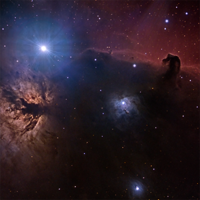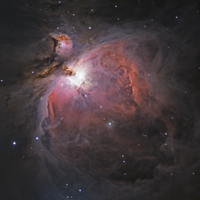Tagged: Emission
02-Aug-2025
A swirl of stellar creation, the Trifid Nebula (M20) reveals its dual personality here: rose-pink hydrogen emission framed by the cool, silvery glow of reflected starlight. Dark dust lanes slice the central cloud into three, giving the nebula its name and lending a dramatic floral symmetry.
29-Sep-2022
When stars like the Sun are near end of life, they send their outer layers into space to create glowing clouds of gas, a planetary nebulae. This ejection of mass is uneven, and planetary nebulae can have complex shapes. This dying star is moving rapidly through space, resulting in a long tail of ionized hydrogen gas.
03-Jul-2022
Perhaps too small of an object for amateur equipment to tease out any details, I decided to try my luck on the Little Gem Nebula. NGC 6818 is roughly 6000 light-years away from Earth. The glow of the cloud is just over half a light-year across.
30-Mar-2022
Although categorised as a hydrogen emission nebula, Sh2-63 lacks the bright red colouring typical of similar objects.
26-Nov-2020
The Red Spider Nebula (also catalogued as NGC 6537) is a planetary nebula located near the heart of the Milky Way.
07-Jul-2019
The Butterfly Cluster, Messier 6, is an open cluster of hot blue stars with the brightest member being an orange giant star. Behind the cluster is the orange light of the Milky Way, and a beautiful cloud of excited Hydrogen alpha gas.
12-Feb-2019
The Skull & Crossbones Nebula is an active star-forming region approximately 20,000 light years away.
10-Aug-2018
IC 4628, sometimes known as The Prawn Nebula, is an emission nebula located around 6000 light-years away in the constellation Scorpius
10-Aug-2018
IC 4628, sometimes known as The Prawn Nebula, is an emission nebula located around 6000 light-years away in the constellation Scorpius
28-Jan-2018
The Vela Supernova Remnant is an expanding bubble of ionized gas 800 light years away, caused by a supernova explosion 12000 years ago. This image is a small section of the bubble, presented as a narrowband combination of light emitted by Hydrogen alpha, Sulfur II and Oxygen III.
08-Jan-2018
NGC 1999 is a dusty blue reflection nebula, embedded in the hydrogen dust cloud of Orion. This narrow band enhanced image shows the light blue NGC 1999 at the center, with the edge of M42 (the Orion Nebula) at the far right. Also shown in the image is the waterfall nebula, the magenta shock wave between NGC 1999 and M42.
11-Aug-2017
After a brief hiatus from astronomy to build a new, larger observatory, I've chosen another difficult target that was surprisingly bright.
19-Jan-2017
The Seagull Nebula a region of nebulosity that lies 1820 light years away, along the border between the constellations Monoceros and Canis Major. It includes the neighboring regions of star clusters, dust clouds and reflection nebulae centered around IC 2177.
04-Jan-2017
Adjacent to the bright blue supergiant star Alnitak shines the ionised hydrogen of the Flame and Horsehead nebulae.
02-Dec-2016
The Orion Nebula is one of the brightest nebulae in the sky, visible to the naked eye. It is seen as the fuzzy middle star in the sword of Orion. The nebula is 1344 light years away and is one of the closest star forming regions to Earth.



